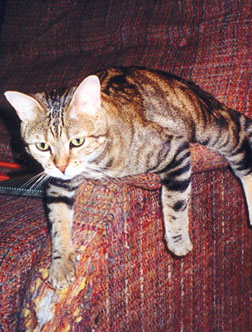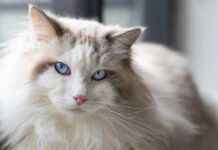Your cat seems to have no respect whatsoever for your property, especially your fancy dining room table, your leather club chair, and, worst of all, the beautiful upright piano that graces a corner of your living room. At every opportunity, he uses the legs of these elegant pieces of furniture as scratching posts, and they look it – so hacked up and pitted that youre actually ashamed of their appearance when friends drop by.

252
A summary solution to the problem occurs to you. You could simply take your furry little friend to a veterinary clinic and have its claws removed. No claws … no more damage to the furniture.
But hold on! Maybe theres a kinder, gentler way to deal with the scratching issue. Indeed, James Richards, DVM, director of Cornell Universitys Feline Health Center and editor-in-chief of CatWatch, would like to see cat owners consider declawing – a procedure called onychectomy – only as “a last resort.”
A Sharp Distinction
Feline claws serve several purposes. They are indispensable to a cat for climbing up tree trunks and maintaining a grip on a slender branch. They allow a cat to seize and hang onto prey. They are also used to mark a cats presence in an area; when scratching at a tree trunk or a patch of turf, a cats pads secrete substances whose odor is detectable to other felines.
Scratching behavior is normal for a cat. It serves to scrape away outer layers of the claws to keep them sharp; it enables a cat to exercise the extending and retracting muscles and ligaments in its paws; and it strengthens an animals legs and shoulders.
A Simple Procedure
The paws are then bandaged securely, with the bandages remaining in place for a variable length of time, depending on the veterinarians preference. In some cases the patient can be taken home immediately following surgery; in other cases, it may have to remain hospitalized for a few days.
Accompanying Risks
In recent years, declawing by means of laser surgery has gained favor with some veterinarians. This procedure, which employs an intensely focused light beam instead of a scalpel to remove the claws, tends to produce less pain, bleeding, swelling and scarring. In Dr. Richardss view, however, laser surgery isnt necessarily superior. As with conventional onychectomy, he says, “It all depends on the hands of the surgeon.”
Reasonable Options
In most cases, it is the destruction of furniture that leads owners to consider declawing their cats. But there are several steps far less extreme than onychectomy that owners can take to discourage this behavior or at least minimize its unpleasant results. For example:
Install a scratching post in your home – a sturdy piece of wood, for instance, about three feet in height, that is covered with carpeting, burlap or other fabric that does not fray but will show the marks and maintain the scent of the cats scratching. Ask your veterinarian about scratching post training.
Trim your cats nails carefully every week or two. If you are wary of undertaking this task, consult your veterinarian or an animal groomer for advice on how to do it properly. (You may also want to view an online video about claw trimming on the Cornell Feline Health Center website at www.felinevideos.vet.cornell.edu/.)
Purchase plastic nail caps that can be glued on to your cat’s claws. These products are widely available, inexpensive and must be replaced only once every month or so.
It is also possible, says Dr. Richards, that, with the guidance of a veterinarian or animal behaviorist, even the most determinedly destructive cat can be trained away from the kinds of scratching behavior that most owners find quite exasperating (and rightfully so).



